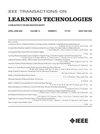聊天机器人的认知参与和人性化对学习效果和学习动机的影响
IF 4.9
3区 教育学
Q2 COMPUTER SCIENCE, INTERDISCIPLINARY APPLICATIONS
引用次数: 0
摘要
根据互动-建构-主动-被动(ICAP)框架,参与建构性认知模式比主动模式产生更好的学习效果。此外,先前对教育聊天机器人的研究表明,增强聊天机器人的人性化可以改善学习。然而,这两个想法并没有被充分地探讨在一起,特别是在基于文本的、无实体的聊天机器人的背景下。本研究探讨了认知参与模式(建设性与主动)和聊天机器人人性(人性化与非人性化)对学习成果和学习动机五个维度的影响。我们对55个聊天机器人用户进行了一个2乘2的阶乘用户实验。通过混合方法分析数据,以检验两个自变量的主要和相互作用效应。关于学习成果,我们的数据显示,与建设性聊天机器人互动的学习者比与活跃聊天机器人互动的学习者表现出更高的学习成果。此外,与非人性化聊天机器人互动的学习者比与人性化聊天机器人互动的学习者报告了更高的学习成果。最后,我们观察到作为学习动机两个维度的紧张压力和感知能力这两个自变量之间存在显著的交互作用。我们的研究将ICAP框架的适用性扩展到基于聊天机器人的学习领域,挑战了聊天机器人的人性化可以改善学习结果的假设,并强调了在设计聊天机器人时探索认知参与模式和聊天机器人的人性化的重要性,以增强用户的学习动机。本文章由计算机程序翻译,如有差异,请以英文原文为准。
The Effects of Cognitive Engagement and Humanness of Chatbots on Learning Outcomes and Motivation
According to the interactive–constructive–active–passive (ICAP) framework, engaging in constructive cognitive modes yields better learning outcomes than active modes. Also, prior studies on educational chatbots suggest that enhancing chatbot humanness can improve learning. However, these two ideas have not been fully explored together, especially within the context of text-based, disembodied chatbots. This study investigates the impact of the cognitive engagement modes (constructive versus active) and chatbot humanness (humanized versus nonhumanized) on learning outcomes and five dimensions of learning motivation. We conducted a two-by-two factorial user experiment with 55 chatbot users. Data were analyzed through a mixed-method approach to examine the main and interaction effects of the two independent variables. Regarding learning outcomes, our data showed that learners who interacted with constructive chatbots showed higher learning outcomes than those who interacted with active chatbots. In addition, learners who interacted with nonhumanized chatbots reported higher learning outcomes than those who interacted with humanized chatbots. Lastly, we observed a significant interaction effect between the two independent variables on tension-pressure and perceived competence, which are two dimensions of learning motivation. Our study extended the applicability of the ICAP framework to the domain of chatbot-based learning, challenged the assumption that the humanness of chatbots can lead to improved learning outcomes, and underscored the importance of exploring both the cognitive engagement modes and the humanness of chatbots when designing chatbots to enhance users’ learning motivation.
求助全文
通过发布文献求助,成功后即可免费获取论文全文。
去求助
来源期刊

IEEE Transactions on Learning Technologies
COMPUTER SCIENCE, INTERDISCIPLINARY APPLICATIONS-
CiteScore
7.50
自引率
5.40%
发文量
82
审稿时长
>12 weeks
期刊介绍:
The IEEE Transactions on Learning Technologies covers all advances in learning technologies and their applications, including but not limited to the following topics: innovative online learning systems; intelligent tutors; educational games; simulation systems for education and training; collaborative learning tools; learning with mobile devices; wearable devices and interfaces for learning; personalized and adaptive learning systems; tools for formative and summative assessment; tools for learning analytics and educational data mining; ontologies for learning systems; standards and web services that support learning; authoring tools for learning materials; computer support for peer tutoring; learning via computer-mediated inquiry, field, and lab work; social learning techniques; social networks and infrastructures for learning and knowledge sharing; and creation and management of learning objects.
 求助内容:
求助内容: 应助结果提醒方式:
应助结果提醒方式:


